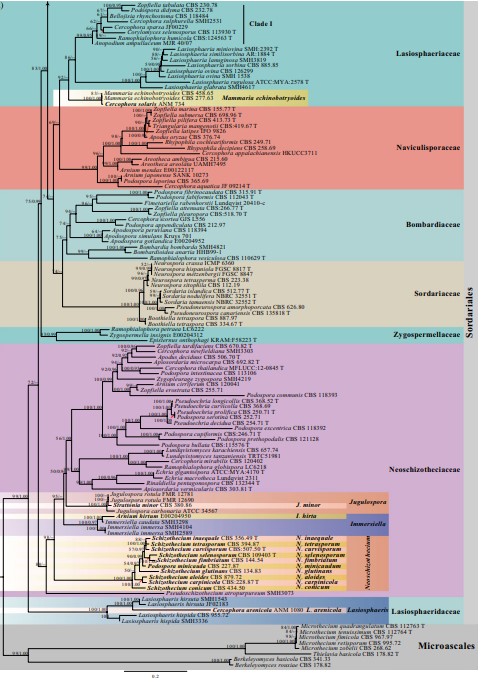Neoschizotheciaceae S.K. Huang & K.D. Hyde, Fungal Diversity: 10.1007/s13225-021-00488-4, [87] (2021)
MycoBank number: MB 558385;Index Fungorum number: IF 558385; Facesoffungi number: FoF 10033
Etymology – Named for Neoschizothecium, the type genus of this family.
Coprophilous or saprobic on wood or isolated from soil. Sexual morph: Ascomata perithecial, solitary to scattered or gregarious, immersed to semi-immersed or superficial, obpyriform or ovoid, membranaceous to coriaceous, brown to black, sometimes semi-transparent, ostiolate, with long or short necks, glabrous or surrounded by hairs, periphysate. Peridium comprising yellowish to pale brown or dark brown cells of textura angularis, textura globulosa or textura epidermoidea. Paraphyses absent, or cylindrical, septate. Asci 4 to multi-spored, unitunicate, cylindrical to clavate, pedicellate, evanescent. Ascospores uni- or bi-seriate, ellipsoidal or triangular, usually 0–1-septate, hyaline to dark brown, with germ pore at one or each end, usually with gelatinous appendages at one or each end, rarely surrounded by gelatinous sheath. Asexual morph: Hyphomycetous. Conidia globose to cylindrical, hyaline to pale brown, smooth-walled, ovate masses on the apex of the phialides (adapted from Marin-Felix et al. 2020).
Type genus – Neoschizothecium S.K. Huang & K.D. Hyde
Notes – The Neoschizotheciaceae clade accommodates Apodus, Cercophora, Echria, Immersiella, Jugulospora, Lundqvistomyces, Neoschizothecium, Pseudoechria, Pseudoschizothecium, Rinaldiella and Zygopleurage based on the molecular data of their generic types, and also several Arnium, Apiosordaria, Podospora, Ramophialophora and Zopfiella species (88%ML, Fig. 26). These taxa are similar to Bombardiaceae, Podosporaceae and Lasiosphaeriaceae in having ellipsoidal ascospores, sometimes with appendages, but are phylogenetically distinct from these three families (Fig. 26). Marin-Felix et al. (2020) introduced this clade as Schizotheciaceae based on Schizothecium. However, Schizothecium is a synonym of Podospora (Podosporaceae) based on the type species S. fimicola, which nests in Podospora in the phylogenetic analysis (Wang et al. 2019a, b; Index Fungorum 2020; this study, Fig. 26). We introduce Neoschizotheciaceae as a new family in Sordariales with 72%ML support (Fig. 26), based on Neoschizothecium. This family includes 11 genera and is characterized by ostiolate ascomata, cylindrical to clavate asci and ellipsoidal ascospores, sometimes with long or short cylindrical or lash-like gelatinous appendages. Marin-Felix et al. (2020) introduced three genera Lundqvistomyces, Pseudoechria and Pseudoschizothecium, which we do not discuss in our study.

Fig. 26 Phylogram generated from maximum likelihood analysis based on combined LSU, ITS, TUB and RPB2 sequence data of Sordariales. The confdence values of bootstrap (BS) proportions from the Maximum Likelihood (ML) analysis (MLBS>50%, before the backslash) and the posterior probabilities (PP) from the Bayesian (BY) analysis (BY-PP>0.90, after the backslash) above corresponding nodes. The ‘–’ indicates lack of statistical support (<50% for ML-BS and<0.90 for BY-PP). Two hundred and thirty-fve strains are included in the combined analyses, which comprise 2877 characters (851 characters for LSU, 509 characters for ITS, 665 characters for TUB, 852 characters for RPB2) after alignment. Strains of Microascales are used as outgroup taxa. The best score in IQ-TREE explores with a fnal likelihood value of − 83459.1151 is presented. The model of each partitioned gene is: LSU: GTR+F+I+G4; ITS: TIM2e+I+G4; TUB: HKY+F+I+G4; RPB2: TIM3+F+I+G4. Strain numbers are noted after the species names and ex-type strains are marked with ‘T’ after the culture number. Alignments are available at TreeBASE (URL: http://purl.org/phylo/treebase/ phylows/study/TB2:S28270)

Fig. 26 (continued)
Species
